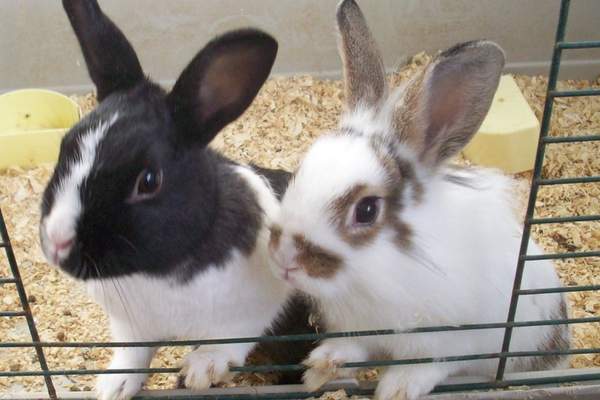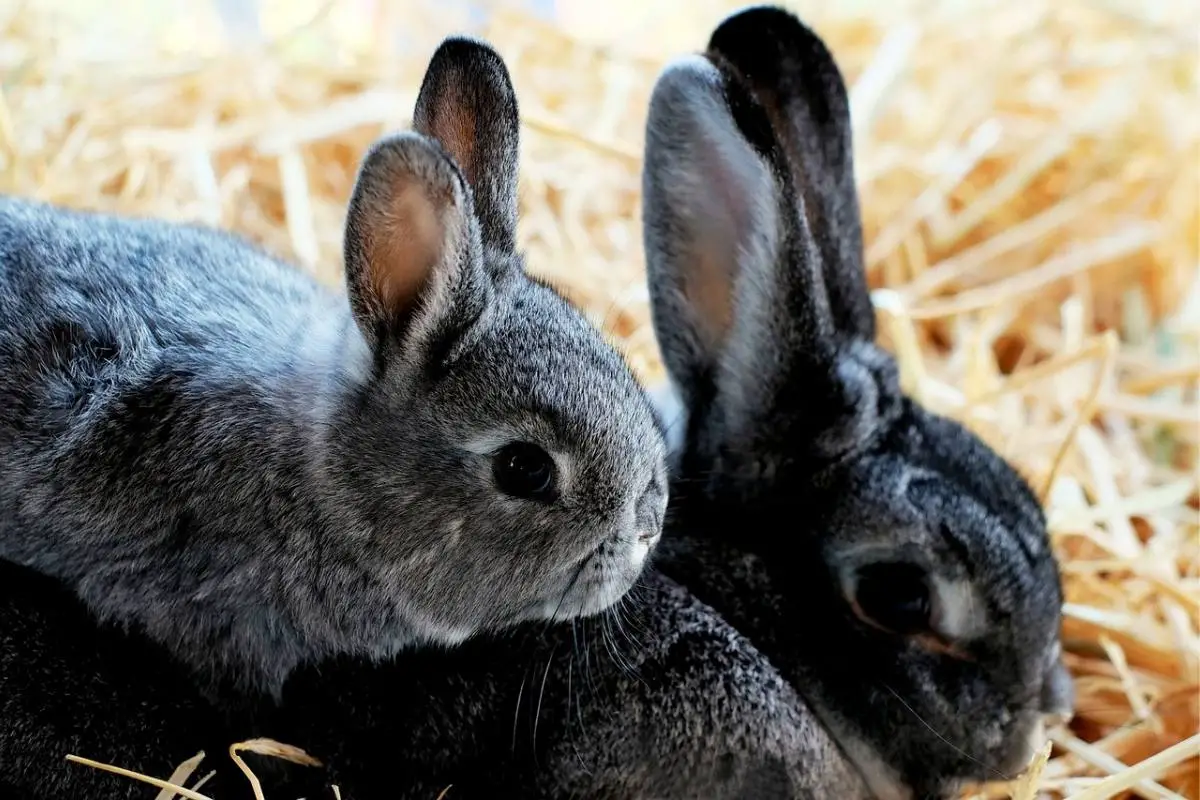Inbreeding among rabbits is a somewhat controversial topic. Breeding related rabbits is common among experienced rabbit breeders, as breeding a rabbit back to one its sire or dam can strengthen positive traits that a breeder desires. However, inbreeding can also cause unwanted negative traits to pop up, including health issues, deformities, and mutations.
So, can you breed rabbits that have the same dad? Most experts agree that breeding full or half siblings is too risky as offspring have a high chance of displaying any negative traits that the siblings have, whether these traits are evident in the parents or not.
This article will discuss the risks involved in breeding rabbits that have the same sire or dam as well as why some breeders may choose to do it anyway. We’ll take a brief look at health problems and deformities that may occur. Finally, we’ll include a few tips on when inbreeding is okay and when it is more likely to cause problems.
Why Breeding Half-Siblings is Risky

Two related rabbits share certain genes, which manifest (or do not manifest) as shared traits. The more closely two rabbits are related, the more genes they share and the stronger those traits will be in these rabbit’s offspring. This can be both a good and a bad thing.
Defects and Health Issues
Inbreeding between siblings or half siblings can lead to rabbits that have deformities, health issues, lower resistance to disease, and overall decreased vigor. Common disorders associated with inbreeding include the following.
- Malocclusion—the rabbit’s teeth do not align and therefore continually become overgrown rather than being worn down as they eat.
- Bone malformation—rabbits may be born with a curved spine, a fragile or incomplete skull, deformed ribs or scoliosis.
- Eye issues—the rabbit’s tear ducts may not work properly, or it may develop cataracts.
- Babies are stillborn or die a few days after being born.
- Increased risk of cancer and heart disease
- Decreased size, vigor, and reproductive abilities
- Decreased resistance to disease, leading to shorter lifespan
Does breeding two rabbits that have the same dad guarantee that you will have to deal with these types of issues in offspring? Not necessarily. It depends on the strength of your two rabbits’ lines and is less likely to happen when half siblings are bred versus when full siblings are bred.
These issues, however, are very common in inbred rabbits. Even breeders that selectively line breed their animals regularly cull the babies produced, meaning they kill any offspring that exhibit any of these defects or deformities, making the ethics of this choice dubious.
Recessive Genes
Two rabbits with the same trait are much more likely to pass that trait on to their offspring, which is why two rabbits with obvious matching negative traits should not be bred. Even if two rabbits have no obvious negative traits, however, they may carry a recessive gene for these traits.
If both rabbits pass the recessive gene to their offspring, the trait will manifest. This is more likely to happen with rabbits that are closely related like siblings or half siblings, which is why abnormalities and mutations more commonly occur among inbred animals.
Why Some Breeders Inbreed Their Rabbits

With all that could go wrong, why is it still fairly common for experienced breeders to breed related rabbits? This is where what we said about either good or bad traits being locked in comes around again. Breeders that inbreed their rabbits are trying to lock in the good traits and get rid of bad ones.
Linebreeding
Some breeders choose to inbreed their rabbits because they are trying to get certain traits—color, temperament, or size. They will commonly breed a daughter back to a sire or a son back to a dam. Pairing offspring back with grandparents is also common practice. Breeding offspring back to a parent or grandparent is called linebreeding.
Experienced breeders consistently use linebreeding if they have an exceptional buck or doe that they are trying to reproduce as closely as possible. Their goal is to lock in good traits so that offspring become more and more consistent, and babies show almost exactly the same traits as their parents. Obviously, things can easily go the other way and lock in negative traits as well.
When breeding siblings or half siblings, it’s more difficult to predict which way the breeding will come out. Because linebreeding is so common, it also may be impossible to find out how closely the siblings are really related.
Is It Okay to Buy a Rabbit From an Inbred Line?
An ethical breeder will only inbreed animals that they feel will strengthen their rabbit’s genes, reducing negative traits and increasing good ones. If you are buying a pedigree or show-quality rabbit, it’s very likely that some linebreeding will have taken place in its near ancestry.
As long as the rabbit seems to be healthy and has no obvious issues, like misaligned teeth or malformation, and the breeder seems knowledgeable and responsible, you shouldn’t need to be concerned about linebreeding. Breeding between cousins is also considered safe.
If you have a chance to look at the rabbit’s pedigree or the pedigree of its parents, this can also help you determine how much inbreeding has taken place. It’s best not to purchase a rabbit that is the offspring of siblings, but half-siblings may be okay as long as the rabbit and its parents are healthy and well-formed.
Questions to Ask Before Breeding Related Rabbits

Two rabbits with the same father should never be bred if there is a high chance that their offspring will suffer from the limited gene pool. This rules out siblings that also share a dam. If you have two rabbits that share a father but have a different mother, asking yourself these questions can help you decide if allowing them to breed is safe and ethical.
– Are both rabbit’s ancestries strong and somewhat diverse? If too much inbreeding has already taken place in the rabbits’ ancestries, the problems associated with it are more likely to show up in your rabbits’ offspring. If the rabbits share a father, you should pay special attention to his health and formation as well as that of his line.
– Does either rabbit have obvious defects, health issues, or negative behavioral traits? As they are related, the offspring of these two rabbits will strongly reflect their traits, especially those inherited from their shared parent, and rabbits with poor health or deformities should not be bred anyway.
– Are my rabbits vigorous and resistant to disease?
– Is this cross likely to make my rabbits’ offspring stronger and better than their parents, or will it make them weaker and of lower quality?
– Am I prepared to deal with any offspring that is born in poor health or suffers from a negative recessive trait in a caring, ethical way?
If your rabbits are half-siblings, but you’re unsure of the rest of their ancestry (pet store rabbits, for example), it’s best to avoid breeding them. You may also wish to get an experienced rabbit keeper or breeder’s opinion on your rabbits’ quality before breeding them. Some issues like proper hip formation or potential dental problems will be easier for them to observe.
Ethical Rabbit Breeding
Any type of rabbit breeding should be undertaken only with the highest ethical standards. This is why you shouldn’t breed any two rabbits that may result in offspring of poor quality or health, whether they are related or not.
Aside from two healthy adult rabbits, you will also need a proper setup and in-depth knowledge of a properly nutritious diet for both adult and young rabbits. Gathering knowledge is essential, as is a relationship with an experienced rabbit breeder or veterinarian that can help you with any issues that you are unprepared to deal with on your own.
Additionally, you will also need to take into consideration what you intend to do with your rabbits’ offspring—healthy or otherwise. Do you have the knowledge and equipment necessary to care for babies that are failing to thrive? Are you planning to sell them as pets once they reach a certain age? Are you prepared to continue caring for any young you are unable to rehome?
Conclusion
As you can see, whether or not it’s okay to breed rabbits that have the same father depends heavily on the individual rabbits and their shared genes. Full siblings should never be allowed to breed. Even with half siblings, there is enough of a risk involved that some would tell you not to try it.
Both good and bad traits are apt to “lock in” when they are passed down through both a dam and a sire, and recessive traits shared by half siblings are not always obvious. Ethically, inbreeding should only be allowed if it will increase the strength of your line rather than weakening it.

